|
Pendants from the Viking Age
|
|
This page contains a selection of our many pendants. Most of them are from the Danish Viking Age, but we occasionally venture far afield, both goegraphically and chronologically. The text will give you all the information known about the piece, that is, where it originated, where it was found, and any other relevant details. For further informations about the dealer nearest you, send an e-mail or visit our dealers on the Internet by clicking related LINKS.
 |
Dess. nr. 114 Hedeby coin, Birka, Sweden, circa 825. Depiction of ship with right stern and no shield, usually considered a trading vessel. Produced in silver and bronze |
 |
Dess. nr. 115 Coin struck in Hedeby circa 825 A.D. Found in Birka, Sweden. Typically Nordic coin showing viking ship with sweeping stern, shield fixed alongside, and a little fish below representing the watery depths. Produced in silver and bronze. |
 |
Dess. nr. 121 A small amulet found in a woman´s grave in Uppland, Sweden. Depicts Odin with horn. Viking Period, exhibited at the Ntional Historical Museum, Stockholm. Produced in silver and bronze |
 |
Dess. nr. 124 Small bronze pendant with Dragon heads found near Tårnby, Amager, Denmark. The original dates from the Viking Period and is on display at the Danish National Museum in Copenhagen. Produced in silver and bronze |
 |
Dess. nr. 125 Coin struck by Knud the Great, 1018-1035. The oldest Roskilde coin, Denmark. Produced in silver and bronze |
 |
Dess. nr. 140 Small cross found in Blekinge, Sweden. Copy in original size. Viking Age. Produced in silver. |
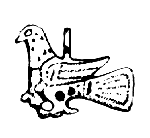 |
Dess. nr. 142 Small charm in form of a pigeon. Found in Blekinge, Sweden. Copy in original size. Viking Age. Produced in silver and bronze |
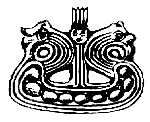 |
Dess. nr. 144 Found in a gravesite at Lillevang, Bornholm, Denmark. Dated circa 1,000 A.D. Stylized Viking ship, originally a brooch. Dragon heads clearly depicted on stern. Produced in silver and bronze. |
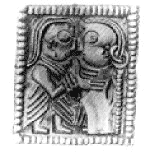 |
Dess. nr. 157 The "Goldgubbe" from Lundeborg, South East Funen. The original was found when excavating a trading center from the iron age. The goldgubbe is a so-called doublegubbe: it depicts two persons a man and a woman, their clothing and hairstyle - a picture of the iron age man. The original was embossed in thin gold foil and originates from the time round 600 A.D. Produced in silver and bronze |
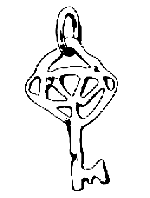 |
Dess. nr. 201 The key to heaven. An early Christian Viking amulet, thought to enable the fallen Viking to open the Heavenly Gate himself. This small magic key is also called St. Petri Reliquary. Site found unknown. Produced in silver |
 |
Dess. nr. 204 Thor´s hammer, silver, Viking Age, 1000 A.D. Found at Mandemark on the island of Møn. Just as the Christians used a cross as a symbol, in the last of the pagan period, pagans used the hammer of their popular god Thor as ornament and amulet. The original is at the National Museum, Copenhagen. Produced in silver. |
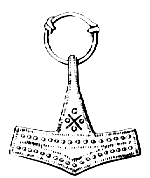 |
Dess. nr. 204a Thor´s hammer, silver, Viking Age, 1000 A.D. Found at Rømersdal on the island of Bornholm. The original is at the National Museum, Copenhagen. Produced in silver and pewter. |
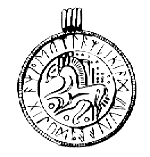 |
Dess. nr. 275 Bracteate with horse and runes, found in Skåne, Sweden. The inscription means: the power of the arrow is the archer´s virility through the blood of animals. A bracteate is a pendant decorated on one side in gold relief. The earliest were made by Nordic dwellers as copies of Roman medals, but in time, an independent Germanic style developed, with motifs from Nordic mythology, for example. Produced in silver and pewter. |
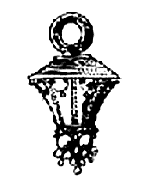 |
Dess. nr. 278 Gold brelogue from the Juellinge find on West Lolland. One of the richest burial finds from the Roman Iron Age, about 200-300 A.D. The original is at the Lolland-Falster Regional Museum. |
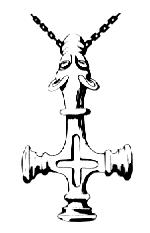 |
Dess. nr. 313 Cast cross from Iceland, Viking Age, about 900-1000 A.D. The mouth of the animal head forms the axis on the longest arm of the cross. This design is often considered to be a combination of a cross and a Thor´s hammer, a special Icelandic design from the period when Christianity gained favour over pagan practies. Similar crosses have been found in Norway. The original is at the National Museum, Iceland. Produced in silver. |
 |
Dess. nr. 81 Cut of a picture stone from Lillbjars, Gotland. The picture stone is approx. 70 cm high, and dates from the period 700-800 A.D. On exhibition at the National Historical Museum, Stockholm, Sweden. Produced in silver. |
 |
Dess. nr. 86 Copy of a small amulet found near Maglehøj, Roskilde. Germanic Iron Age. Produced in silver and bronze. |
 |
Dess. nr. 92 Small bronze figure found near Akureyri, Iceland. Depicts Thor with hammer, possibly made around the year 1,000 A.D. Original at the National Museum in Reykjavik, Iceland. Produced in silver and bronze. |
|
|
|